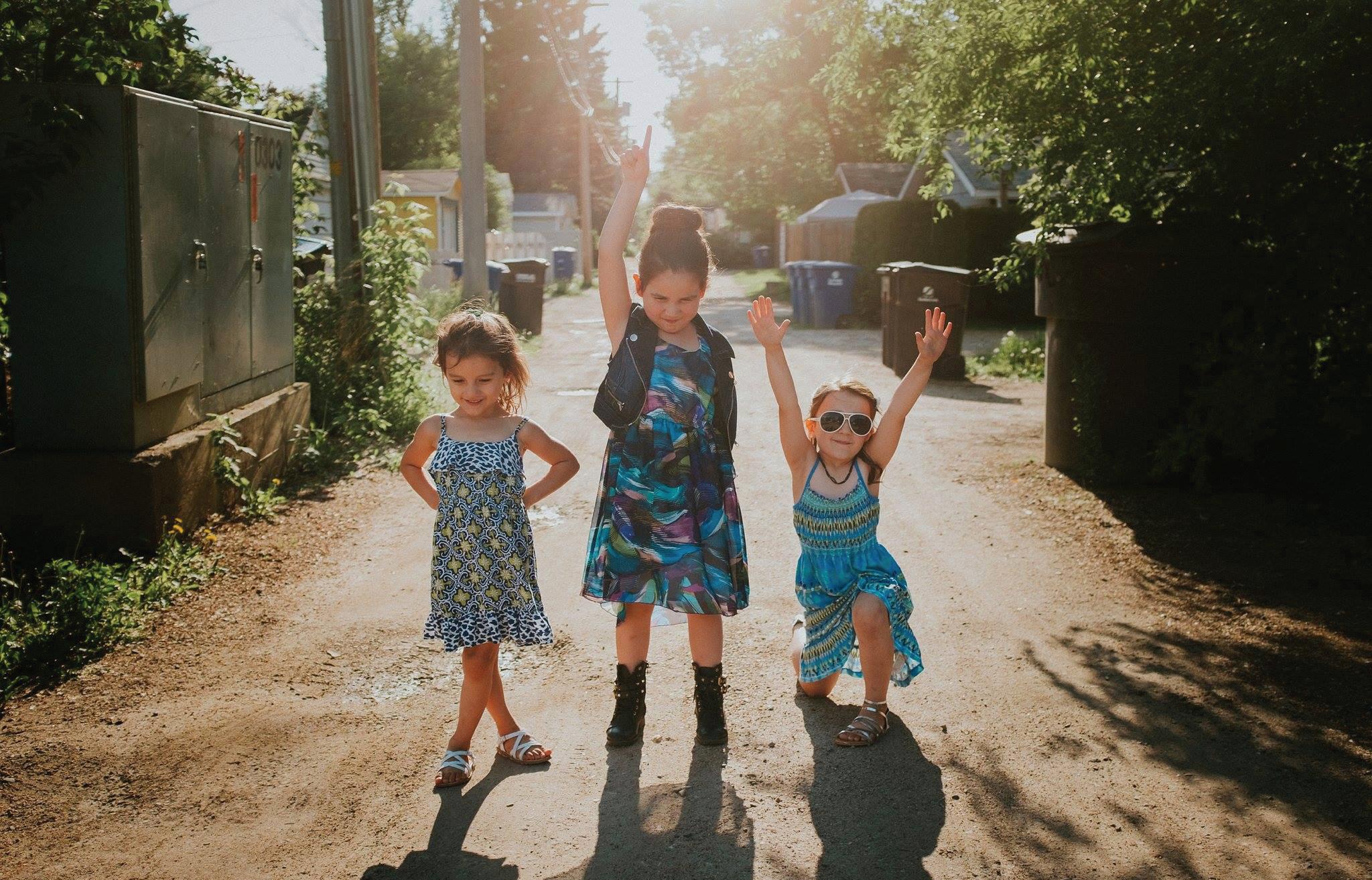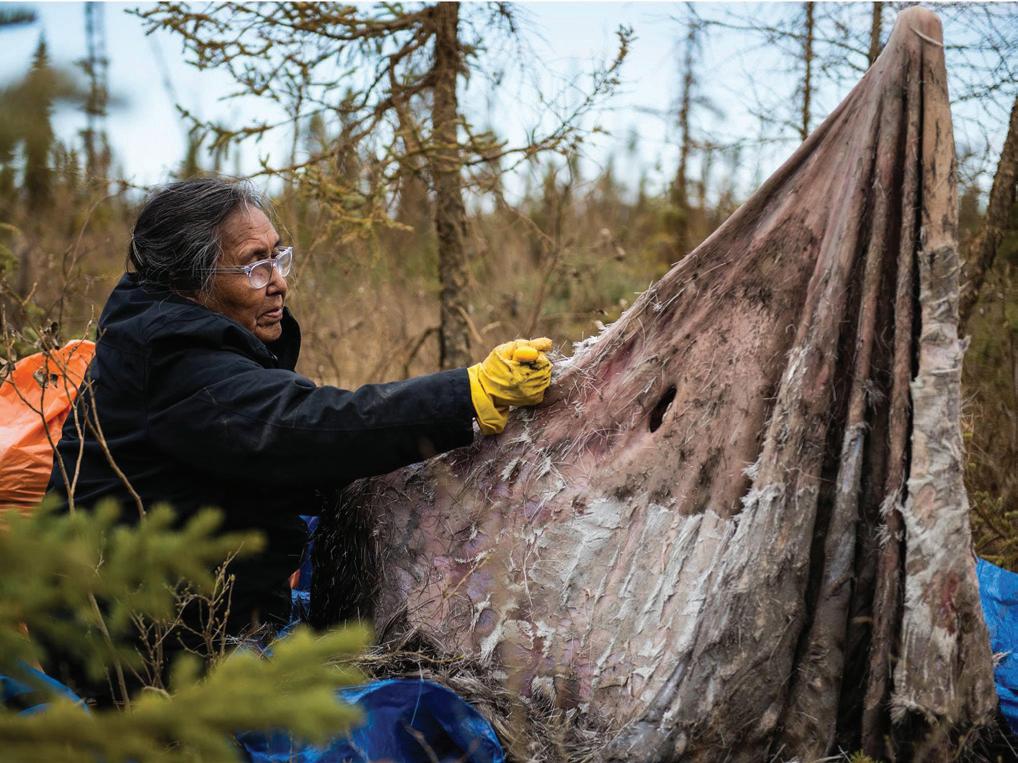
7 minute read
THE WOMEN OF TEA&BANNOCK
BY KRISTA STEVENS
A roundtable discussion with the women of Tea&Bannock

TEA&BANNOCK IS AN ART COLLECTIVE born out of Tenille Campbell’s wish for “a community, a group of women I can talk to about editing, writing, art, and what it means processing all of that through Indigenous eyes.”
Visiting Tea&Bannock is like sitting around the table with smart, thoughtful friends; their excitement and passion for interpreting their experiences through stories, art, and photography is both inspiring and uplifting.
We spoke with the women of Tea&Bannock about community, inclusion, cultural appropriation, and breaking down Indigenous stereotypes.

Jessica Wood, “The 27th Annual February 14th, Downtown Eastside Women’s Memorial March, Vancouver BC, 2017, Coast Salish Territory.” Elders lead the march. They stop, say prayers, and leave medicine at locations where women missing from the community were last seen or found murdered.
KS: You started Tea&Bannock on a whim. What surprised you about a project that began as a spontaneous idea?
Claudine Bull: The most surprising thing about the project is how much it has grown into a strong community of women. To me that’s amazing, fascinating, and a privilege.
Tenille Campbell: For me, it was the instant support. This was a personal art project for myself — I saw a void and I needed support and encouragement from like-minded women — but I never thought about how this need would be reflected in a larger community, and that the experiences and stories at T&B would resonate so strongly throughout Indian Country. It opened my eyes to the amazing artists, photographers, curators, beaders, and painters out there, who can identify and share and laugh with us now. Tea&Bannock built a community, and I’m grateful for that.

Tenille Campbell/Sweetmoon Photography, “Campbell Girls, Kelry, Aerie, Ava.” Summer 2016.

Shayla Snowshoe, “In Her Element.” Gwich’in Jijuu (Grandmother) Mary Effie Snowshoe. Preparing the hide. Dempster Highway by Fort McPherson, Northwest Territories.
KS: What’s the most important thing you’ve learned as a result of sharing your work on the site?
Joi T. Arcand: It’s not so bad to put yourself out there. As a photo-based artist, I am usually behind the camera. That is a conscious decision. I am private and so sharing bits of my life and my artistic process was a little bit daunting at first. However, I’ve received a lot of positive feedback through the site, which has been a great encouragement to continue doing what I’m doing.
Amanda Laliberte: I have a voice. As contributors to Tea&Bannock, every post we share speaks from our experiences as Indigenous women photographers. There is always something new to be said. With the light — and camera in hand — we continue to document our lives and raise each other up so that our voices are heard.
Claudine Bull: My voice matters — no matter how controversial or “scary” it may be to share my opinion or thoughts on different subjects — it matters. People will agree and disagree. It doesn’t make it less valid.

Tenille Campbell’s “Teacups and Beadwork, Lace and Birchbark,”
KS: Of all the stories shared at Tea&Bannock, which story resonates most with you?
Shawna McLeod: Tenille Campbell’s “Teacups and Beadwork, Lace and Birchbark,” which was a collaboration with several female Indigenous artists who recreated the Mad Hatter’s Tea Party from Alice in Wonderland. I think I connected to this story and photography because that is ultimately what I like to do with my own photography — create, collaborate, and capture!
Joi T. Arcand: I love the post that Claudine shared when she announced she was expecting. She got personal and I appreciate her bravery in discussing the topic in such a thoughtful way. I related to a lot of what she wrote, even though I am not a parent. The best thing about Tea&Bannock is that while we have never met in real life, I feel we’ve gotten to know each other by reading each other’s posts.
Caroline Blechert: One of my favourite stories on Tea&Bannock was about Nicole Lapierre. She mentions collaborating with other photographers and creatives as much as possible, and how sharing is the key to growing. I’ve been implementing this advice in my life a lot lately since reading about it, so thank you Nicole!

Caroline Blechert, “UrbanNative” featuring jewellery by Creations for Continuity. Model/ makeup by Dezbah Evens.
Jessica Wood: Indigenous women are often presented through lenses that we did not ask for and do not see ourselves through: Hollywood maidens both virginal and savage. We are portrayed as stereotypes or we are erased entirely. So often our regalia is appropriated for fashion, but we are excluded from even that imagery. My favourite posts of my own have been on the Memorial March and Shane Sable. My favourite posts from others include Tenille’s stylized Alice (in Wonderland) shoot, Shawna’s post about Dene Games, and Amanda’s post “Making Bannock.”
Here we get to share our interests, our experiences, and our experiments without it being in relationship or contrast to anything or anyone else. It’s so powerful to see the variety of our lived experience captured and shared. We can explore our strength, sexuality, representation, politics, and insight together. I feel very supported as a queer Indigenous woman who works in a lot of activist spaces. I feel like I have colleagues. That’s new for me as an Indigenous photographer and as a professional. It’s such a stark contrast to my family and community life.

Amanda Lalibert, “Abby raises up her daughter Eva Edna Kitai Coon from the `Namgis First Nation.”
Amanda Laliberte: The post that leaves me most in awe is Tenille Campbell’s “Teacups and Beadwork, Lace and Birch Bark.” Her words and photographs do an amazing job of giving light to the Indigenous female experience. Like Tenille, I also grew up in wonderment of Alice’s adventures and to see Tenille take that story and indiginize the Mad Hatter Tea Party through her lens was simply mind-blowing. And of course, she collaborated and shared the space with family, friends, and community to execute her idea and create, as Tenille says, “a little bit of Indigenous magic.” It reminds us that we do our best when we are able to work together.
When I scroll through Instagram and Pinterest looking at other people’s stylized photographs, I am inspired by some; yet most of the time I am left searching for more that I can connect with. The worst is when the collaborators appropriate Indigenous content into their stylized photo shoots. That’s why I like Tenille’s post so much, because it’s for real. I am able to connect with the work because I get it. For me what lies beyond the frames and beneath the layers of tea cups, beads, lace, and birch bark is the voice of Indigenous women.

Claudine Bull, “Claudine with one week old daughter, Alba.” December 2016.
KS: T&B’s tagline is “Indigenous women photographers, telling story, sharing light.” What does it mean to share light and why is it important at Tea&Bannock?
Claudine Bull: Sharing light ties into the belief that what I have to say is important, and that there are others out there who will share and spread that same light.
Shawna McLeod: I want to share my story with a wider audience and to educate people about the Northwest Territories. Living North of 60 isn’t easy but it sure is amazing. As an Indigenous photographer from the Northwest Territories, I often feel it is my duty to shed a light on where I come from; to capture the variety of Indigenous cultures, the beautiful pristine land, and to celebrate all that the North has to offer. I hope that people will learn, feel, and take away positivity through my photography and stories on Tea&Bannock.

Shawna McLeod, “Dene Beauty.” Collaboration with designer Heather Dickson from Dickson Designs (Tinglit), MUA Angela Jack from Kamamak Cosmetics (Cree), and model Charlene Menacho (Dene).
Tenille Campbell: There are a lot of magic spots in my urban community of Saskatoon that have amazing light. These are spots in back alleys, behind a cluster of trees, down a hidden dirt road, off the beaten path. Places where the light shines evenly and clearly during that magic hour, the light that all photographers chase. And I found a lot of these places through driving around and looking, by accident, by chance.
When asked about where I shot a specific image, I’ll share. I’ll tell them how to get there. I’ll bring up a map and stick a pin and text it to them. I’ll warn them about times to go, when to avoid, and what worked best for me.

Caroline Blechert, “Snowfest16".

Joi T. Arcand, “Tombstone Territorial Park, Yukon, 2011.”
This concept is a foundation of Tea&Bannock. But instead of actual locations on the land, we are sharing knowledge, experiences, frustrations, and accomplishments. We are sharing communities and the people within them. We are showing each other our families, our favourite foods, and what makes us giggle. We treat this blog as a place where we get together to share our daily thoughts — no matter how mundane it may seem to us at the moment, it’s often appreciated and understood within our group, and now our larger online community, on a deeper level.
When we tell our stories, we are sharing our light.
teaandbannock.com





